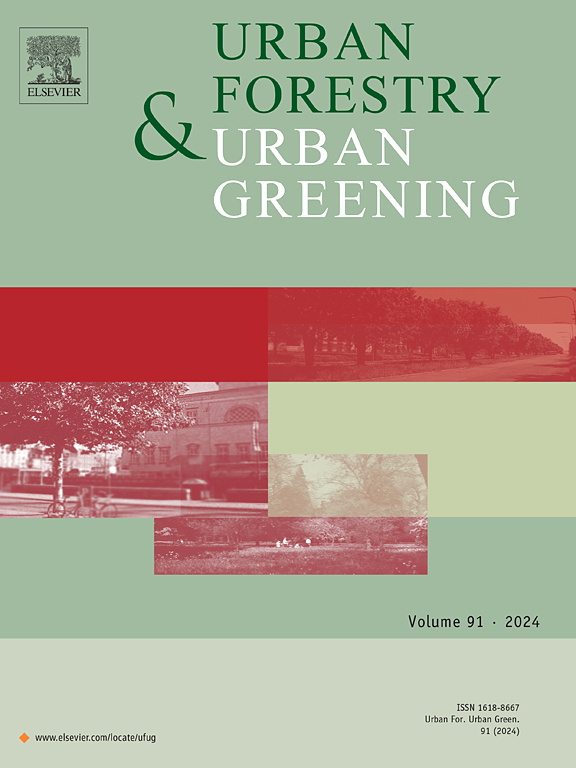城市化和不透水覆盖改变了喜马拉雅地区快速城市化景观中的河岸植物群落
IF 6.7
2区 环境科学与生态学
Q1 ENVIRONMENTAL STUDIES
引用次数: 0
摘要
不透水的覆盖物,如道路、人行道、建筑物和停车场,可以防止水渗透,从而增加地表径流。城市河岸不透水覆盖的扩大通过水文变化改变了物种多样性和组成,对河岸生态系统构成了重大威胁。作为水生和陆地环境交界的动态生态系统,河岸区在水生生态中起着至关重要的作用,特别是在生物多样性、河岸稳定性、营养动态和水文过程方面。本研究采用基于样地的植物区系抽样,调查了城市化,特别是不透水覆盖(量化为PTIA,总不透水面积百分比)对不丹廷布市快速城市化景观中河岸植物群落的影响。此外,还研究了其他环境变量和土壤化学性质,以确定它们是否混淆了PTIA的影响。结果表明,PTIA对河岸植物群落的多样性和组成有显著影响。总体而言,较高的PTIA水平支持更多的植物物种,包括外来物种,但与参考点相比,α-多样性最低,树木丰度降低(p <; 0.001)。低PTIA区支持Calamagrostis scabrescens-Elaeagnus umellata群落,而低PTIA区支持Rumex nepalensis-Equisetum spum群落。在PTIA阈值约为60% %时,物种多样性和群落结构发生了显著变化(p <; 0.05),表明在此阈值之后发生了实质性的生态变化。除土壤pH独立影响植物群落而不影响PTIA效应外,其他环境变量和土壤化学性质对河岸植物群落均无显著影响。研究表明,PTIA是快速发展的城市河岸景观中植物群落变化的主要预测因子。PTIA与植物群落之间的关系凸显了PTIA在城市生物多样性管理中的重要性,因为它可以预测维持健康的河岸生态系统所需的植被面积。这些发现表明,快速城市化的城市可以通过评估现有的不透水覆盖和建立适当的PTIA阈值来重新调整城市发展和河岸生物多样性管理策略,以平衡城市发展与河岸环境保护。本文章由计算机程序翻译,如有差异,请以英文原文为准。
Urbanisation and specifically impervious cover alter riparian plant communities in a rapidly urbanising landscape in the Himalayas
Impervious covers, such as roads, pavements, buildings, and parking lots, prevent water infiltration, thereby increasing surface runoff. The expansion of impervious cover along riverbanks in urban areas poses a significant threat to riparian ecosystems by altering species diversity and composition through hydrological changes. As dynamic ecosystems at the interface between aquatic and terrestrial environments, riparian areas play a crucial role in aquatic ecology, particularly in terms of biodiversity, bank stability, nutrient dynamics, and hydrological processes. Employing plot-based floristic sampling, this study investigated the effects of urbanisation, particularly impervious cover (quantified as PTIA, Percentage of Total Impervious Area), on riparian plant communities in the rapidly urbanising landscapes of Thimphu City, Bhutan. Additionally, other environmental variables and soil chemical properties were examined to determine whether they confounded the impacts of PTIA. The results showed that PTIA had a significant impact on the diversity and composition of riparian plant communities. Overall, higher levels of PTIA supported a greater number of plant species, including exotic species, but exhibited the lowest α-diversity and reduced tree abundance compared to reference sites (p < 0.001). These areas favoured Rumex nepalensis–Equisetum spp. community, while low PTIA supported the Calamagrostis scabrescens–Elaeagnus umbellata community. Significant changes in species diversity and community structure were observed at a PTIA threshold of approximately 60 % (p < 0.05), indicating substantial ecological alterations beyond this point. Except for soil pH, which influenced plant communities independently rather than confounding PTIA’s effects, other environmental variables and soil chemical properties did not have any significant effects on riparian plant communities. Our study revealed that PTIA was the primary predictor for changes in plant communities in rapidly developing urban riparian landscapes. The relationship between PTIA and plant communities highlights the importance of considering PTIA in urban biodiversity management, as it can predict the extent of vegetated land required to sustain healthy riparian ecosystems. These findings suggest that rapidly urbanising cities can realign their urban development and riparian biodiversity management strategies by assessing existing impervious cover and establishing appropriate PTIA thresholds to balance urban growth with the conservation of riparian environments.
求助全文
通过发布文献求助,成功后即可免费获取论文全文。
去求助
来源期刊

Urban Forestry & Urban Greening
FORESTRY-
CiteScore
11.70
自引率
12.50%
发文量
289
审稿时长
70 days
期刊介绍:
Urban Forestry and Urban Greening is a refereed, international journal aimed at presenting high-quality research with urban and peri-urban woody and non-woody vegetation and its use, planning, design, establishment and management as its main topics. Urban Forestry and Urban Greening concentrates on all tree-dominated (as joint together in the urban forest) as well as other green resources in and around urban areas, such as woodlands, public and private urban parks and gardens, urban nature areas, street tree and square plantations, botanical gardens and cemeteries.
The journal welcomes basic and applied research papers, as well as review papers and short communications. Contributions should focus on one or more of the following aspects:
-Form and functions of urban forests and other vegetation, including aspects of urban ecology.
-Policy-making, planning and design related to urban forests and other vegetation.
-Selection and establishment of tree resources and other vegetation for urban environments.
-Management of urban forests and other vegetation.
Original contributions of a high academic standard are invited from a wide range of disciplines and fields, including forestry, biology, horticulture, arboriculture, landscape ecology, pathology, soil science, hydrology, landscape architecture, landscape planning, urban planning and design, economics, sociology, environmental psychology, public health, and education.
 求助内容:
求助内容: 应助结果提醒方式:
应助结果提醒方式:


